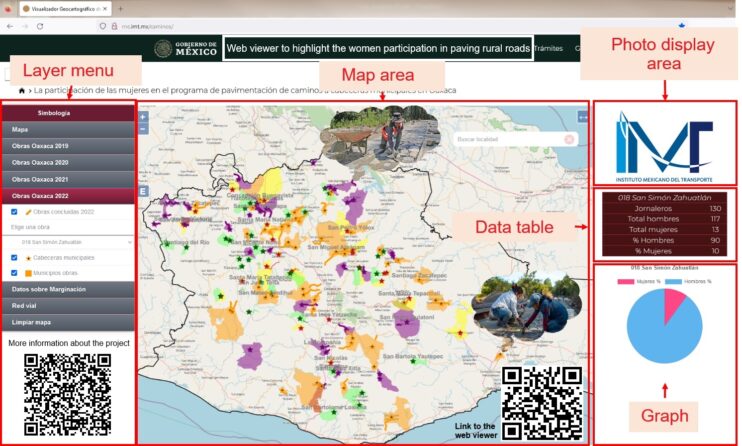The transportation infrastructure construction could be an area of opportunity to increase women’s participation in the labor market, especially in rural road construction and maintenance activities that employ labor-intensive methods.
In the case of Mexico, it is available the participation of women in the Road Paving Program of the Secretariat of Infrastructure, Communications and Transportation. A web viewer was developed to highlight the participation of women in the paving program in the state of Oaxaca (Gradilla-Hernández, L. A. and Morales-Bautista, E. M., 2023), with free licensing and open-source software, with the objective of visualizing the georeferenced rural roads and the percentage of participation, both men and women in each of the roads, for the period 2019-2022. The web viewer is available through the following link: http://rnc.imt.mx/caminos
In the 25 roads concluded in 2019, 642 women participated out of 2,640 workers, that is, 24.3 % of the participants were women. In the 33 roads concluded in 2020, 18.7% of the participants were women. In 2021, 33 roads were completed, with a participation of 15.8% of women. And finally, in 2022, women represented 18% of the total participants.
The workers belonged to the community and most of the women belonged to indigenous communities, some are heads of household, so their participation helped them to improve their quality of life and, in general, raise their self-esteem. In addition, female workers increased their participation in the community and in leadership roles, encouraging more women to follow their example.
To continue encouraging the participation of women from the community, a mission approach is suggested to address the social sustainability of rural road works, where an important part is the training of women and the adequacy of working conditions for their full immersion. Such a mission approach would also help to integrate the community and rescue traditions, as well as, to adapt rural roads to climate change. Since a mission helps to obtain a strategic planning and to define both the projects and the actors that must participate in order to achieve the mission’s objective, which is usually the resolution of complex problems that must be addressed from different areas.
For more information in Spanish about the project:
https://www.gob.mx/imt/acciones-y-programas/mujeres-pavimentando-caminos-en-oaxaca
Luz Angélica Gradilla-Hernández and Elsa María Morales-Bautista
Mexican Institute of Transportation, Mexico
